- About Us
- Columns
- Letters
- Cartoons
- The Udder Limits
- Archives
- Ezy Reading Archive
- 2024 Cud Archives
- 2023 Cud Archives
- 2022 Cud Archives
- 2021 Cud Archives
- 2020 Cud Archives
- 2015-2019
- 2010-2014
- 2004-2009
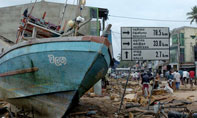 |
Three Days after the Tsunami: |
I was eating breakfast, watching Sri Lanka having a terrible time in the cricket in New Zealand. The news ticker mentioned floods in the eastern and southern coastal areas. I didn't take too much notice of that' floods are common in those regions of the island; this was not new. Already war damaged, the eastern communities were held together by a fragile cease'fire agreement. Outside of the main roads, and the densely populated villages and towns, many areas (including beaches) remain uncleared of landmines and unexploded ordinances but the cease'fire agreement had brought hope. Still, much work was needed to resolve old animosities.
On the twenty'sixth, news traveled slowly. We knew of an earthquake off Indonesia, but had no information of its impact on Sri Lanka. Panic and chaos ruled the newsrooms of the local and international broadcasters who were relying on reports by traumatized locals. These were inconsistent, incoherent, and it was difficult to gauge a full picture of the disaster. Information from the LTTE (Liberation Tigers of Tamil Eelam) controlled areas was negligible.
The enormity of the disaster started sinking in about four hours later. I was feeling increasingly helpless. There wasn't much I could do. At midnight, when we saw an advertisement on a local TV station (Rupavahini) for vehicles to ferry emergency aid to affected areas in the south, Sanjiva (my brother'in'law) and I went to assist. We were told that they needed lorries and drivers' the Nissan Bluebird was not really suitable.
We stayed there to help sort out literally tons of clothes, food and water that people had donated. As usual, some individuals were using this as a way to purge their wardrobes of fashion disasters ' many dating from the early 70s. A couple of hundred people had gathered there, most that had started around 5pm. We filled three lorries that were dispatched to the southern and eastern coasts. There was concern for the safety of transport to the LTTE controlled areas, as permits to travel had not been pre'arranged, but hope prevailed for safe passage.
At the same time, individuals in the unaffected areas of Sri Lanka were grouping together, organizing the collection and distribution of emergency relief items ' drinking water, baby food, dry'rations, clothing, and medicines. The conflict was briefly forgotten as people helped each other regardless of ethnic groupings.
It was here that we first heard rumors of a train carrying around a thousand passengers being derailed roughly seventy kilometers south of Colombo; the engine and a couple of the carriages swept about 100 meters from the railway tracks.
The main road south from Colombo (Galle Road) would have carried a large amount of traffic, buses, cars and lorries. The railway was another popular mode of transport. During my childhood I traveled this railway from Galle to Colombo frequently.
The southern area was reliant on tourism, cottage industries (rope making, souvenir making etc). A drop in tourist numbers has a large impact on the families that live(d) there. Tourism had recently been showing signs of improvement after the cease'fire agreement. I have never traveled to the northern and eastern areas of the country, but couldn't even imagine how severe this impact would be there.
The next day, the feeling of helplessness continued. There was nothing I could do in the short term. Sanjiva was calling around trying to identify the best way we could help. The death toll kept mounting, and continued to do so. We found a suitable role as drivers for doctors on behalf of the Sri Lanka Red Cross the next day (28 December).
In preparation, we picked up some emergency rations and loaded the cars.
The doctors were on a triage mission to Galle (120km from Colombo). We were advised that we could pick up medicines at a Red Cross station at Beruwala, about halfway between Colombo and Galle.
I took several photographs, being careful not to photograph people, and not to exploit their unfortunate situation.
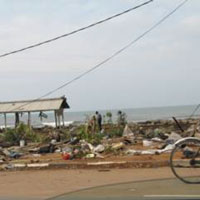 As we went along Galle road, we came across the first signs of damage. We were just ten kilometers from the city centre of Colombo. The image on the left shows the frame of what would have been a dwelling. The rubble on either side of this frame is other destroyed homes. Prior to the 26th, the view of the sea was obstructed by buildings of varying structural quality.
As we went along Galle road, we came across the first signs of damage. We were just ten kilometers from the city centre of Colombo. The image on the left shows the frame of what would have been a dwelling. The rubble on either side of this frame is other destroyed homes. Prior to the 26th, the view of the sea was obstructed by buildings of varying structural quality.
A bit further south, we came to Payagala (30km from Colombo). The railway station was completely destroyed, and debris strewn everywhere. Military earthmoving machines had traveled down the Galle road and made it passable again, but the number of heavy and light vehicles carrying relief items and people to the affected areas made travel slow and difficult.
A passerby, having seen the Red Cross sign on our vehicle implored us to stop and go to a nearby refuge. Apparently none of the relief efforts were reaching areas closer to Colombo; they were concentrating on reaching the further away.
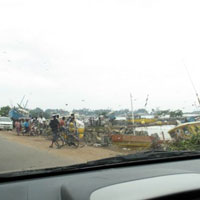 From this point onwards, the scenario was more distressing. We were traveling in an air'conditioned car and isolated from the environment outside. The people helping out had their faces covered with masks, to reduce the smell of decomposing bodies and rotting fish. I put the window down briefly, and had to quickly wind it back up.
From this point onwards, the scenario was more distressing. We were traveling in an air'conditioned car and isolated from the environment outside. The people helping out had their faces covered with masks, to reduce the smell of decomposing bodies and rotting fish. I put the window down briefly, and had to quickly wind it back up.
As we approached Beruwala harbour, we could see fishing boats grounded on both sides of the road. This used to be a favourite stopping area for travellers to and from Colombo. Here, many families would have been enjoying a morning tea when the tsunami struck here. As you can see from the photographs, all vessels in the harbour were destroyed. By the time we reached the area the road had been cleared, and vessels and debris moved to the roadsides.
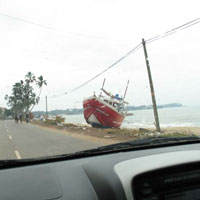 The radio announcers were continuously requesting further information on the whereabouts of people; usually last seen traveling close to the coast.
The radio announcers were continuously requesting further information on the whereabouts of people; usually last seen traveling close to the coast.
Evidence of the damage to the railway system was clearly visible. The soil underneath the sleepers had been washed away and the rails were buckled, pretty much all the way south from Payagala onwards.
Frequently we'd spy crowds rushing to a gathering. Later I was told this was a common occurrence where new bodies had been discovered.
At the Red Cross supply point in Beruwala we were told to collect medicines for use in emergency clinics on our return journey from Galle as in Beruwala they only had boxes of Panadol.
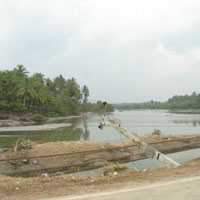 Continuing on our journey, we reached a point where all traffic was diverted inland, as the road was still impassable between Ambalangoda and Hikkaduwa. The train accident happened between these two towns and rubble and bodies were still being cleared.
Continuing on our journey, we reached a point where all traffic was diverted inland, as the road was still impassable between Ambalangoda and Hikkaduwa. The train accident happened between these two towns and rubble and bodies were still being cleared.
Small back roads led us on the return towards Galle. These usually quiet and narrow roads were now gridlocked with traffic. Our journey was very slow. We eventually reached our destination after traveling for over six hours.
I lived in Galle, an old town with narrow and winding streets, until I was about thirteen and this was my first visit here in fifteen years. The streets seemed much narrower. Tsunami damage was visible almost 3km from the coast. The once familiar landmarks were not visible; progress or tsunami damage, I cannot say. What was clear is that the city had been absolutely devastated.
The watermark here was almost ten meters. Power and telephone lines had fallen; I even saw a boat that had landed on top of a building.
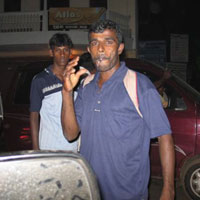 We first went to the co'operative hospital (a private clinic and surgery). This is a three'storey building; the watermark here was visible on the second floor. The operating theatre used to be on the first floor. The pharmacy staff had salvaged what they could and moved all the medicines to the third floor. While the doctors were assessing the situation, I talked to the staff in my rusty Sinhalese.
We first went to the co'operative hospital (a private clinic and surgery). This is a three'storey building; the watermark here was visible on the second floor. The operating theatre used to be on the first floor. The pharmacy staff had salvaged what they could and moved all the medicines to the third floor. While the doctors were assessing the situation, I talked to the staff in my rusty Sinhalese.
I found out that the Central, another private surgery, was completely destroyed and inaccessible. We couldn't find any information about the welfare of the staff or the patients at that surgery.
Mahamodara (which literally means 'big sea') hospital was a maternity hospital about thirty meters from the water's edge. Dwellings along the coast usually obstructed the view of the sea from the road. Today, I could see the ocean.
This large multi'storey hospital was built in the 1920's. When the first wave struck, a caesarian operation was proceeding in one of the theatres. This was a relatively mild wave; a warning of what was to follow. It prompted the hospital staff to evacuate new and expectant mothers. Two nurses were looking after three babies in incubators. They had to make a decision when evacuating, and leave one baby behind. This baby was lost when the second wave hit.
The doctors in the theatre continued with their operation, without power under torchlight. Both mother and baby survived.
The injured were being cared for in buildings that simply didn't look safe but there was no alternative available. With the exception of a few isolated incidents which came to light a few days later, the residents were helping each other out, organizing sanitation, drinking water and food.
The doctors who traveled with us had the information they needed. Although their triage mission was successful, they were feeling quite distressed for not having been able to offer immediate assistance. They needed to be back in Colombo. It was dark when we started our return journey to Colombo.
We went north on Galle Road. At Hikkaduwa, we randomly selected one of the many places of religious worship functioning as a refugee camp to deliver our small quantity of relief items. It was a small Buddhist temple.
This temple housed about fifty families in the audience hall. Once the word spread that there were doctors visiting, villages started arriving for treatment. The closest hospital (which usually has about fifty beds) was temporarily being used as a morgue. The nearest hospital, Karapitiya (a suburb of Galle), was two hours a way and it was full.
Unfortunately we didn't have any medicine apart from our personal prescriptions. Sanjiva gave his Ventolin inhalator to be shared by two elderly gentlemen.
While we were there, a young child fell and cut her head. This wound required sutures we didn't have. The doctors did a great, makeshift job of patching her up. The cut was under her hairline, and any scar would be hidden ' we gave her mild antibiotics.
Here I met a young boy who was about five years old. He had been operated on for a tumor in September and still needed monthly hospital visits and a daily collection of pills, certainly not of the type to be generally included in emergency medical relief packages.
People had either survived the tsunami or didn't make it. There was no middle ground. We didn't see anyone with serious injuries. It was mainly cuts, bruises and occasional fractures. There were many patients with pre'existing conditions who needed regular treatment and who had lost all their possessions including prescription medicines.
At Hikkaduwa we were again diverted inland. At night, it was increasingly difficult and slow driving. Large earthmoving equipment was moving south to help clear the rubble. A few local lads filled in as traffic police and directing traffic. The whistle my niece gave me as a birthday present is now being used by one of these volunteers.
We barely made a scratch on the support needed at the campsite we visited.
The major concern will be in the coming few days, as hygiene levels go down. Hopefully the residents will practice the advice on cleanliness and food preparation given by the doctors.
It will take a very long time to recover from this disaster. Will this be the catalyst for lasting peace on the island? Will communities remember the similarities that unite are greater than the differences that divide? We'll have to wait and see.
